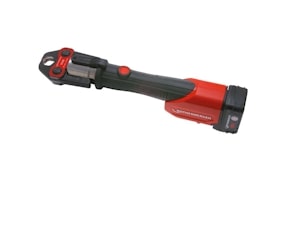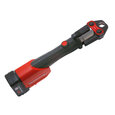Copper Pipe Crimping Tool

Figure 1: Pipe crimping tool
A copper pipe crimping tool creates watertight seals in copper piping systems by applying pressure to the fitting over the pipe. The tool creates pressure that deforms the fitting slightly, causing it to grip onto the pipe tightly. They are widely used in plumbing, heating systems, gas lines, and DIY projects. This article explores the various types of crimping tools and how to use one for an application.
Table of contents
- What is a copper pipe crimping tool?
- How to use a crimping tool
- Crimping tool types
- Selecting a crimping tool
- How to remove a copper press fitting
- Crimping tools for stainless steel press fittings
- FAQs
View our online selection of tube crimpers!
What is a copper pipe crimping tool?
Crimping is a method in which two pieces of metal or other malleable material are combined by deforming one or both to create a seal. This process is achieved without the need for heat, making it a popular choice over soldering, especially in places where using a flame is not safe or practical.
A press fitting joins pipes together. They have a built-in sealing element, typically an o-ring, that ensures a watertight seal when the fitting is properly crimped onto the pipe using a crimping tool. These tools often have interchangeable dies to accommodate different sizes of pipes and fittings.
How to use a crimping tool
Materials needed
- Copper pipe crimping tool
- Copper pipes
- Copper press fittings
- Measuring tape
- Pipe cutter
- Deburring tool
- Marker
Procedure
- Identify the right copper pipe size: Using a measuring tape and marker, measure and mark the correct length of copper pipe needed for the project.
- Cut the copper pipe: Once the pipe length has been marked, use a pipe cutter to cut the pipe. Ensure the cut is straight and clean, as crooked or jagged edges can compromise the fitting's seal.
- Deburr the pipe: Use a deburring tool to remove any burrs or imperfections from the edges after cutting. This step is crucial as any leftover burr can damage the o-ring within the press fitting, leading to potential leaks.
- Insert the press fitting: Insert the copper pipe into the press fitting. Ensure that the pipe is pushed into the fitting for a proper seal. Some fittings have a depth mark to indicate how far the pipe should be inserted.
- Prepare the crimping tool: Select the correct size of crimping jaws for the crimping tool based on the size of the pipe and fitting. Attach the jaws to the tool following the manufacturer's instructions.
- Crimp the fitting: With the crimping jaws securely attached, place the crimping tool over the press fitting. Ensure the tool is perpendicular to the pipe to achieve a uniform crimp. Once the tool is in place, squeeze the handle to start crimping. Some tools may require multiple crimps around the fitting to ensure a proper seal.
- Inspect the crimp: A properly crimped fitting will connect seamlessly to the pipe with no visible gaps. Some crimping tools have an indicator that shows whether a crimp is complete or not.
Crimping tool types
Copper pipe crimping tools, or press tools, come in various types, each designed to suit different applications and user preferences. Here are some of the common types:
- Manual: Handheld tools require physical force to crimp the fittings onto the pipe. They are portable, affordable, and ideal for small-scale projects or tight spaces.
- Battery-powered: These tools are battery-operated to provide the crimping force. They are ideal for larger projects as they can reduce fatigue and increase productivity with automatic operation.
- Hydraulic: These tools use hydraulic force to crimp the fittings onto the pipe. They are designed for heavy-duty tasks.
- Adjustable crimping tools: These tools come with interchangeable jaws or dies that can be swapped out to fit different sizes of pipes and fittings. They can be manual, battery-operated, or hydraulic.
Selecting a crimping tool
Selecting a copper pipe crimper involves considering the application's specific requirements. Here are some factors to consider:
- Pipe size: Copper pipes come in different sizes, and selecting a crimping tool that matches the pipe size is crucial. Some crimping tools are adjustable and can work with various pipe sizes, while others are fixed and designed for one specific pipe size.
- Type of crimp: There are different crimps, like PEX and press crimps. For example, PEX crimping tools are designed for crimping copper rings onto PEX pipes, while press crimping tools are for joining copper pipes using press fittings. Select the tool that fits the crimp type of the application.
-
Type of crimping tool:
- Manual: Manual crimping tools are cheaper, portable, and suitable for small projects. However, they require more physical effort.
- Battery operated: Battery-operated tools are easier to use and suitable for larger projects. But they require regular charging and are more expensive.
- Hydraulic: Hydraulic tools are powerful, efficient, and ideal for professional use. However, they are heavier and more expensive.
- Ease of use: The tool should be comfortable and easy to use. Look for features like ergonomic handles, ratchet mechanisms, and a design that makes it easy to crimp in tight spaces.
-
Additional features: Certain crimping tool models have additional features.
- Gauges: Display the amount of force applied, which is helpful in preventing damage to the pipe.
- Indicators: Show when the crimp is complete
How to remove a copper press fitting
Removing a copper press fitting can be complex and usually requires a specific puller tool designed for this purpose. However, it's important to note that not all press fittings are designed to be reusable. Here are the general steps to follow:
- Use a rotary tool with a cutting wheel to carefully cut a slit along the length of the fitting. Be careful not to cut into the pipe itself.
- Once the fitting is cut, use a pair of pliers to twist and remove the cut piece.
- Clean the pipe with a wire brush or sandpaper to remove any leftover fitting material before installing a new fitting.
Crimping tools for stainless steel press fittings
Crimping tools are designed to work with specific materials like copper, stainless steel, or PEX (cross-linked polyethylene). However, the tool's capacity to crimp a specific material will depend on its design and the hardness of the material. For instance, a tool designed for copper may not work effectively on stainless steel due to the latter's higher hardness level. Always check the tool's documentation for compatible materials and sizes.
FAQs
What is a crimping tool for copper pipe?
A crimping tool for copper pipe joins copper pipes and fittings by applying pressure to create a watertight seal, typically used in plumbing and heating systems.
Are copper press fittings reliable?
Yes, copper press fittings are reliable. They provide a secure, leak-free connection for copper pipes when installed correctly.
Is a copper press fitting tool the same as a copper pipe crimping tool?
Yes, a copper press fitting tool is the same as a copper crimping tool. Both terms refer to the tool used to join copper pipes and fittings by applying pressure to create a seal.




